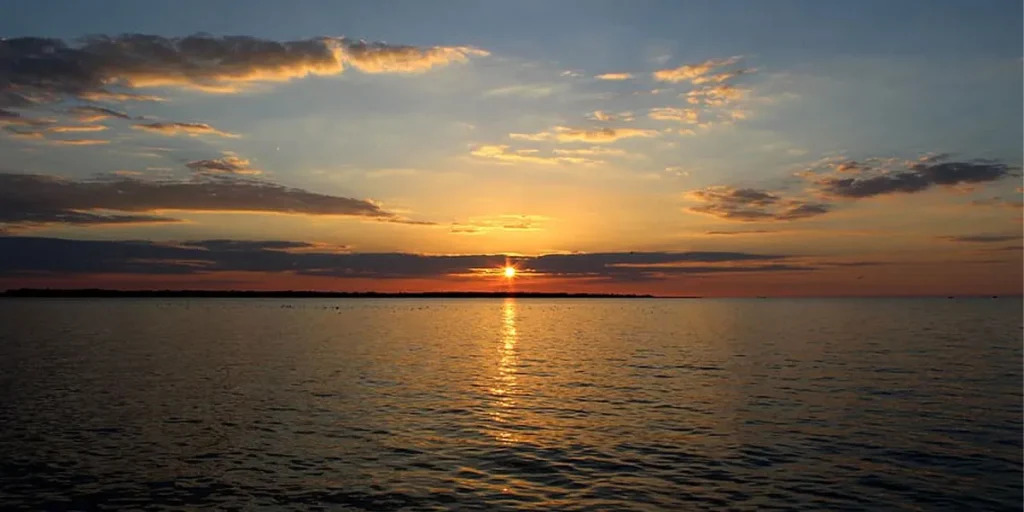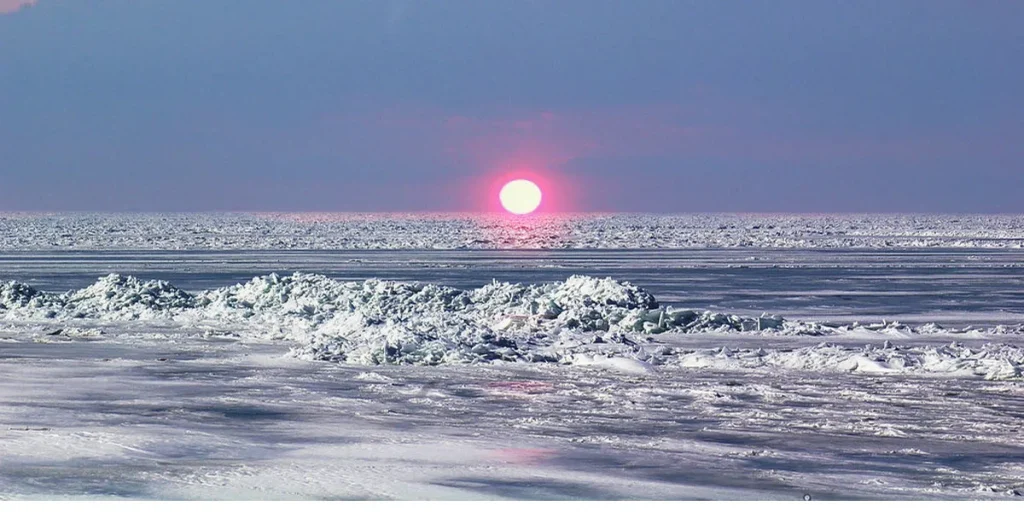Lake Erie spans up to 57 miles wide at its widest point. It stretches approximately 241 miles in length.
Lake Erie is one of the five Great Lakes in North America, renowned for its economic and ecological significance.
Situating on the international border between Canada and the United States, it serves as a key natural resource for both nations.
Its vast expanse supports numerous industries, including fishing, shipping, and tourism, playing a critical role in the regional economy.
As the fourth largest lake by surface area of the Great Lakes, Lake Erie also provides water for millions, making it a central component of local water systems.
This freshwater body’s wide reach contributes to diverse habitats, supporting a rich array of wildlife and reinforcing its importance in environmental conservation efforts.

Greatness Of The Great Lakes
The Great Lakes form an impressive collection of freshwater lakes on the border between the United States and Canada.
They are filled with beauty and wonder, serving as a natural playground and a vital resource for both nations.
Together, they encompass a vast area that has captivated explorers, settlers, and scientists for centuries, with each lake holding its unique characteristics.
Geographical Majesty Of The Great Lakes
Imagine a series of interconnected water bodies so large they can be seen from space. The Great Lakes offer that grandeur. Here’s a glimpse into their majesty:
- Lake Superior: The largest and deepest, offering breathtaking landscapes.
- Lake Michigan: The second-largest, exclusively within the US, known for its sandy shores.
- Lake Huron: Renowned for its beautiful Georgian Bay.
- Lake Ontario: The gateway to the Atlantic via the St. Lawrence Seaway.
- Lake Erie: The fourth largest by surface area and the shallowest, crucial for fishery.
Lake Erie In The Great Lakes Tapestry
Lake Erie plays a unique role in the Great Lakes system. Notable aspects include:
| Characteristic | Description |
|---|---|
| Location | Bordered by Ontario, Michigan, Ohio, Pennsylvania, and New York. |
| Size | It spans roughly 241 miles in length and up to 57 miles in width. |
| Ecosystem | Supports a diverse range of wildlife and plant species. |
| Economic Role | Vital for transportation, recreation, and commercial fishing. |
As the shallowest of the Great Lakes, Lake Erie heats up and cools down faster than its neighbors.
This contributes to its rich biodiversity, making it a crucial habitat for countless species. The lake’s moderate width facilitates the navigability which enhances trade and tourism in the region.
Lake Erie’s Scale And Size
Lake Erie, one of the Great Lakes, boasts an impressive size. Nestled between Canada and the United States, it’s famous for its fisheries and bustling ports. Understanding its true scale can be astonishing.
Comparing Dimensions
The Great Lakes are a wonder, each with unique sizes. Here’s how Lake Erie stands among its siblings:
| Lake Name | Width (Miles) | Length (Miles) | Average Depth (Feet) | Maximum Depth (Feet) |
|---|---|---|---|---|
| Superior | 160 | 350 | 483 | 1,333 |
| Michigan | 118 | 307 | 279 | 923 |
| Huron | 183 | 206 | 195 | 750 |
| Erie | 57 | 241 | 62 | 210 |
| Ontario | 53 | 193 | 283 | 802 |
Key Measurements: Width, Length, And Depth
Lake Erie’s dimensions make it exceptional. Let’s dive into its specific measurements:
- Width: At its widest, Lake Erie spans about 57 miles.
- Length: The lake stretches roughly 241 miles from end to end.
- Average Depth: It has an average depth of around 62 feet, shallow compared to other Great Lakes.
- Maximum Depth: The deepest point reaches approximately 210 feet.
Historical And Contemporary Views

The vast expanse of Lake Erie has long captured the imagination. Its size has been a topic of both historical intrigue and modern significance.
Recognizing how perceptions of the lake’s width have evolved over time enriches our understanding of its role in North America.
Historical Significance Of Lake Erie’s Size
Lake Erie, the fourth largest of the Great Lakes, boasts historical importance tied to its size. Native American tribes revered its bounteous waters.
European explorers and settlers quickly realized the lake’s strategic and economic potential, leading to notable historical events:
- The Battle of Lake Erie in 1813 showcased its military significance.
- The lake’s width influenced the development of shipping routes.
- As a boundary between free and slave states, it served as a beacon for the Underground Railroad.
Modern Implications Of Lake Erie’s Width
Today, Lake Erie’s width, approximately 53 miles (85 kilometers) at its widest point, plays a key role in various sectors. Here are some modern-day implications:
| Aspect | Implication of Width |
|---|---|
| Economic | Supports commercial shipping, fostering economic growth. |
| Environmental | Impacts climate and local weather patterns. |
| Recreational | Offers diverse activities like fishing, boating, and water sports. |
| Scientific | Provides a natural laboratory for ecological and geological studies. |
As conservation efforts advance, the lake’s size is crucial for habitat restoration and pollution mitigation.
Lake Erie’s width not only shapes the shoreline communities but also plays a vital role in regional biodiversity.
Navigating Lake Erie
For sailors and adventurers alike, navigating the waters of Lake Erie is an experience like no other.
This great lake, known for its impressive size, offers a breadth of maritime opportunities.
Its width is significant, acting as a path between various ports and a playground for boating enthusiasts. Let’s explore.
Maritime Routes And The Importance Of Width
Lake Erie’s width greatly influences the design of maritime routes. It spans roughly 57 miles at its widest point, providing ample space for various navigation pathways. This width allows for:
- Efficient cargo transport between the United States and Canada.
- Safer recreational sailing due to reduced traffic congestion.
- Flexible route planning for commercial vessels.
A broad water body like Lake Erie ensures effective handling of commodities and passenger travel, stabilizing the region’s economy.
Challenges And Opportunities For Navigators
Despite its size, Lake Erie presents unique navigation challenges. These challenges include:
| Challenge | Opportunity |
|---|---|
| Shifting sandbars | Advanced mapping technologies |
| Variable weather conditions | Enhanced safety protocols |
| Busy shipping lanes | Improved traffic management |
Navigators must constantly adapt to these conditions while the width allows for the development of new maritime technologies.
Ecological Perspective

Exploring the ecological aspect of Lake Erie reveals a fascinating tapestry of life and land. Lake Erie, the eleventh largest lake on the planet by surface area, spans an impressive width – offering a diverse array of habitats for various species.
Its ecological significance lies not just in size but in the variety of life it supports.
Habitat Diversity Within Lake Erie’s Wide Range
Lake Erie’s vast expanse hosts numerous environments. These range from deep, cold waters to warm, shallow areas.
The lake boasts rich wetlands and vibrant coastal regions, all crucial for wildlife. Below are key habitats within this wide setting:
- Wetlands: Vital breeding grounds for fish and birds.
- Sand and Stone Beaches: Provide nesting sites for turtles and shorebirds.
- Open Water: Home to many fish species.
- Submerged Aquatic Vegetation: Supports aquatic insects and spawning fish.
Environmental Concerns And Conservation Efforts
Lake Erie, like many ecosystems, faces challenges. Pollution, invasive species, and habitat loss threaten its diversity.
The table below highlights major issues and efforts to protect Lake Erie:
| Issue | Conservation Effort |
|---|---|
| Water Quality | Initiatives to reduce nutrient runoff and algal blooms. |
| Invasive Species | Programs aimed at controlling species like zebra mussels. |
| Habitat Destruction | Efforts to restore wetlands and other critical habitats. |
Experience The Width For Yourself
Have you ever stood by a vast expanse of water and marveled at its sheer size? Lake Erie, one of the Great Lakes, offers a unique opportunity to experience such awe.
Stretching out as far as the eye can see, Lake Erie’s width is a natural wonder that beckons explorers and nature lovers alike.
Traveler’s Guide To Exploring Lake Erie
Embark on an adventure across Lake Erie’s expansive waters. Various entry points along the shoreline provide access to boat tours, hiking trails, and scenic drives. Each offers a distinct perspective of this majestic lake.
Put on comfortable shoes, pack a camera, and prepare for a journey that will capture your imagination.
- Boat Tours: Feel the lake’s breadth beneath you.
- Hiking Trails: Walk alongside the lake and sense its vastness.
- Scenic Drives: Drive around the edge for panoramic views.
Best Vantage Points To Comprehend The Lake’s Breadth
Understanding Lake Erie’s width is best achieved through strategic vantage points. Whether perched atop a cliff or standing on a tranquil beach, the lake’s immensity is palpable.
| Location | View Description |
|---|---|
| Presque Isle State Park | 360-degree views from the lighthouse |
| Lake Erie Bluffs | Elevated platforms offer unobstructed vistas |
| Point Pelee National Park | Witness the lake merge with the horizon |
Visit these vantage points at sunrise or sunset for a visual spectacle. Witness the sun’s rays dance across Lake Erie’s surface, showcasing the true breadth of this remarkable body of water.
FAQs About the Width of Lake Erie
How Wide Is Lake Erie At Its Widest Point?
Lake Erie spans 57 miles at its widest point, creating a broad expanse of water.
Where Is The Deepest Part Of Lake Erie Located?
The deepest point of Lake Erie is located in its northeastern basin near the Long Point Escarpment.
Can You See Across Lake Erie?
Lake Erie spans approximately 241 miles across at its widest point. This vast expanse makes it the fourth-largest Great Lake by surface area.
How Many Miles Across Lake Erie?
Lake Erie spans approximately 241 miles across at its widest point. This vast expanse makes it the fourth-largest Great Lake by surface area.
Conclusion
Lake Erie’s span is impressive, making it a wonder among the Great Lakes. It’s clear that this body of water’s width varies from 30 to 57 miles, reflecting the unique geography shaping its shores.
Whether for education or planning a visit, understanding Lake Erie’s dimensions offers valuable insights.
So, next time you gaze across its expansive waters, remember the vastness that unfolds before you.
Resources:
https://www.epa.gov/greatlakes/lake-erie
https://www3.erie.gov/environment/lake-erie-watershed-protection-alliance
